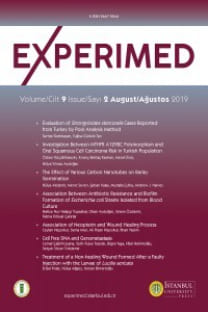Fetal Hand Anomalies: 18 Cases Diagnosed Between 2020-2022 from a Single Tertiary Care Center
Fetal Hand Anomalies: 18 Cases Diagnosed Between 2020-2022 from a Single Tertiary Care Center
Polydactyly, syndactyly, prenatal diagnosis,
___
- 1. Goldfarb CA, Shaw N, Steffen JA, Wall LB. The prevalence of congenital hand and upper extremity anomalies based upon the New York congenital malformations registry. J Pediatr Orthop 2017; 37(2): 144-8. [CrossRef] google scholar
- 2. Ekblom AG, Laurell T, Arner M. Epidemiology of congenital upper limb anomalies in 562 children born in 1997 to 2007: a total population study from Stockholm, Sweden. J Hand Surg Am 2010; 35: 1742-54. [CrossRef] google scholar
- 3. Oberg KC, Feenstra JM, Manske PR, Tonkin MA. Developmental biology and classification of congenital anomalies of the hand and upper extremity. J Hand Surg Am 2010; 35(12): 2066-76. [CrossRef] google scholar
- 4. Manske PR, Oberg KC. Classification and developmental biology of congenital anomalies of the hand and upper extremity. J Bone Joint Surg Am 2009; 91(Suppl 4): 3-18. [CrossRef] google scholar
- 5. Barham G, Clarke NM. Genetic regulation of embryological limb development with relation to congenital limb deformity in humans. J Child Orthop 2008; 2(1): 1-9. [CrossRef] google scholar
- 6. Umair M, Ahmad F, Bilal M, Ahmad W, Alfadhel M. Clinical genetics of polydactyly: an updated review. Front Genet 2018; 9: 447. [CrossRef] google scholar
- 7. Ahmed H, Akbari H, Emami A, Akbari MR. Genetic overview of syndactyly and polydactyly. Plast Reconstr Surg Glob Open 2017; 5(11): 1549. [CrossRef] google scholar
- 8. Jose R, O'Brien M, Burke F. Congenital hand anomalies. In: Bentley G, editor. European Surgical Orthopaedics and Traumatology. Berlin, Heidelberg: Springer; 2014.p.1653-73. [CrossRef] google scholar
- 9. Richards S, Aziz N, Bale S, Bick D, Das S, Gastier-Foster J, et al. ACMG Laboratory Quality Assurance Committee. Standards and guidelines for the interpretation of sequence variants: a joint consensus recommendation of the American College of Medical Genetics and Genomics and the Association for Molecular Pathology. Genet Med 2015; 17(5): 405-24. [CrossRef] google scholar
- 10. De Smet L. IFSSH. International Federation for Societies for Surgery of the Hand JSSH. Japanese Society for Surgery of the Hand. Classification for congenital anomalies of the hand: the IFSSH classification and the JSSH modification. Genet Couns 2002; 13(3): 331-8. google scholar
- 11. Ezaki M, Baek GH, Horii E, Hovius S. IFSSH scientific committee on congenital conditions. J Hand Surg Eur 2014; 39: 676-8. [CrossRef] google scholar
- 12. Tonkin MA, Tolerton SK, Quick TJ, Harvey I, Lawson RD, Smith NC, et al. Classification of congenital anomalies of the hand and upper limb: development and assessment of a new system. J Hand Surg Am 2013; 38(9): 1845-53. [CrossRef] google scholar
- 13. Uzun H, Özdemir FDM, Üstün GG, Sakarya AH, Bitik O, Aksu AE. Oberg-Manske-Tonkin classification of congenital upper extremity anomalies: The first report from Turkey. Ann Plast Surg 2020; 85(3): 245-50. [CrossRef] google scholar
- 14. Wall LB, McCombe D, Goldfarb CA, Lam WL; ICHAD study group. The Oberg, Manske, and Tonkin classification of congenital upper limb anomalies: A consensus decision-making study for difficult or unclassifiable cases. J Hand Surg Am 2022; S0363-5023(22)423-3. [CrossRef] google scholar
- 15. Waters AM, Beales PL. Ciliopathies: an expanding disease spectrum. Pediatr Nephrol 2011; 26(7): 1039-56. [CrossRef] google scholar
- 16. Hildebrandt F, Benzing T, Katsanis N. Ciliopathies. N Engl J Med 2011; 364(16): 1533-43. [CrossRef] google scholar
- 17. Hibberd CE, Bowdin S, Arudchelvan Y, Forrest CR, Brakora KA, Marcucio RS, Gong SG. FGFR-associated craniosynostosis syndromes and gastrointestinal defects. Am J Med Genet A 2016; 170(12): 3215-21. [CrossRef] google scholar
- 18. Shah HH, Doddabasappa SN, Joseph B. Congenital posteromedial bowing of the tibia: a retrospective analysis of growth abnormalities in the leg. J Pediatr Orthop B 2009; 18(3): 120-8. [CrossRef] google scholar
- 19. Moran SL, Jensen M, Bravo C. Amniotic band syndrome of the upper extremity: diagnosis and management. J Am Acad Orthop Surg 2007; 15: 397-407. [CrossRef] google scholar
- 20. Gogola, G. Constriction Band Syndromes. In: Abzug J, Kozin S, Zlotolow D, editors. The Pediatric Upper Extremity. New York: Springer; 2015.p.413-29. [CrossRef] google scholar
- 21. Ermito S, Dinatale A, Carrara S, Cavaliere A, Imbruglia L, Recupero S. Prenatal diagnosis of limb abnormalities: role of fetal ultrasonography. J Prenat Med 2009; 3(2): 18-22. google scholar
- Yayın Aralığı: Yılda 3 Sayı
- Başlangıç: 2011
- Yayıncı: İstanbul Üniversitesi
Melis KARTAL YANDIM, Mesut BİLGİN
Clues to the Harmful Effects of Aspartame on Liver Morphology and Function
Emine Rümeysa HEKİMOĞLU, Birsen ELİBOL, Ceyhun TORUNTAY, Seda KIRMIZIKAN, Ozge PASİN, Ufuk SARIKAYA, Damla ALKHALİDİ, Mukaddes EŞREFOĞLU
Sümeyye YILMAZ, Elif TUFAN, Güzin Göksun SİVAS, Begüm GÜREL GÖKMEN, Ercan DURSUN, Dilek ÖZBEYLİ, Göksel ŞENER, Tuğba TUNALI-AKBAY
Caspase-9 rs1052576 Polymorphism is not Associated with Glioblastoma in Turkish Patients
Deryanaz BİLLUR, Fatma Tuba AKDENİZ, Seda GÜLEÇ, Zerrin BARUT, Cumhur Kaan YALTIRIK, Turgay İŞBİR
Activation-Induced Cytidine Deaminase Expression in Patients with Chronic Myeloid Leukemia
Emin OGUZ, Aynur DAĞLAR ADAY, Akif Selim YAVUZ
A Histological Evaluation of the Effect of Ghrelin on Wound Healing in Rats
Esin AK, Kerime ULUSOY-DAG, Feriha ERCAN, Ahmet CORAK
Ender COŞKUNPINAR, Betul Nılgun ENGIN
Miray ATACAN YAŞGÜÇLÜKAL, Zeynep ACAR, Birgül BAŞTAN, Aytül MUTLU, Özlem ÇOKAR
Sertaç Argun KIVANÇ, Berna AKOVA, Merih KIVANÇ
Merve ERKISA GENEL, Selin SELVİ, Ismail YILMAZ, Remzi Okan AKAR, İlhan YAYLIM, Abdurrahman ŞENGÜL, Engin ULUKAYA
